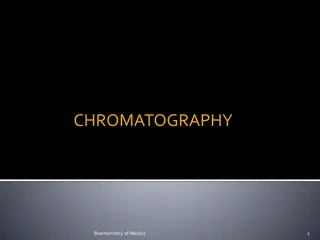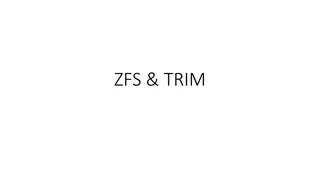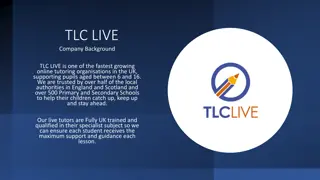Understanding Thin Layer Chromatography (TLC) Process
A TLC plate coated with an adsorbent is used for separation and analysis. Spot samples, develop plates carefully, visualize spots, calculate Rf values, and interpret data to identify compounds based on their movement. TLC helps in identifying unknown substances and estimating sample purity.
Download Presentation

Please find below an Image/Link to download the presentation.
The content on the website is provided AS IS for your information and personal use only. It may not be sold, licensed, or shared on other websites without obtaining consent from the author. Download presentation by click this link. If you encounter any issues during the download, it is possible that the publisher has removed the file from their server.
E N D
Presentation Transcript
Developing the Plates After preparing the development chamber and spotting the samples, the plates are ready for development. Be careful to handle the plates only by their edges, and try to leave the development chamber uncovered for as little time as possible. When the plates are removed from the chamber, quickly trace the solvent front (the highest solvent level on the plate) with a pencil.
Identifying the Spots (visualization) If the spots can be seen, outline them with a pencil. If no spots are obvious, the most common visualization technique is to hold the plate under a UV lamp. Many organic compounds can be seen using this technique, and many commercially made plates often contain a substance which aids in the visualization of compounds.
Visualizing Agents Alkaloids: Dragendorff s reagent Cardiac glycosides: Antimony trichloride Sugar: Aniline phthalate Amino acids: Ninhydrin
Interpreting the Data The Rf(retention factor) value for each spot should be calculated. It is characteristic for any given compound on the same stationary phase using the same mobile phase for development of the plates. Hence, known Rfvalues can be compared to those of unknown substances to aid in their identifications.
(Note: Rfvalues often depend on the temperature and the solvent used in the TLC experiment. the most effective way to identify a compound is to spot known substances authentic - next to unknown substances on the same plate.) In addition, the purity of a sample may be estimated from the chromatogram. An impure sample will often develop as two or more spots, while a pure sample will show only one spot
Summary A TLC plate is a sheet of glass, metal, or plastic which is coated with a thin layer of a solid adsorbent (usually silica or alumina). A small amount of the mixture to be analyzed is spotted near the bottom of this plate. The TLC plate is then placed in a shallow pool of a solvent in a developing chamber so that only the very bottom of the plate is in the liquid. This liquid, or the eluent, is the mobile phase, and it slowly rises up the TLC plate by capillary action. As the solvent moves past the spot that was applied, an equilibrium is established for each component of the mixture between the molecules of that component which are adsorbed on the solid and the molecules which are in solution.
In principle, the components will differ in solubility and in the strength of their adsorption to the adsorbent and some components will be carried farther up the plate than others. When the solvent has reached the top of the plate, the plate is removed from the developing chamber, dried, and the separated components of the mixture are visualized. If the compounds are colored, visualization is straightforward. Usually the compounds are not colored, so a UV lamp is used to visualize the plates.























